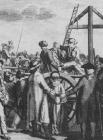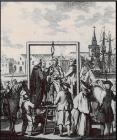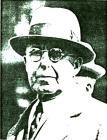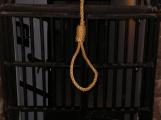1
Former gallows location, currently used as a wheelchair ramp.27 August 2004
668 Brunswick Street, Fredericton, N.B

2
Three out of the five hangings which occurred in Fredericton took place at the location seen here. As you stroll down the wheelchair ramp into the old exercise yard, if you stop at the first landing, you will be standing where the temporary sheds once stood. These sheds were built for the sole purpose of carrying out hangings.4
Harboard & Nelson - 1786Fredericton's first murder trial
David Nelson and William Harboard were sentenced to hang for the shooting death of a Native man, Pierre Bonwah. Nelson and Harboard fired warning shots at two people they believed to have stolen their hogs. One of the shots accidentally hit and killed Bonwah.
Nelson and Harboard were tried on June 14, 1786. Meanwhile the Maliseets, intent on seeing justice done, camped out around the presiding Judge Kingsclear's home. The accused were not allowed to be represented by a lawyer, because people charged with capital offences were not given legal counsel until 1842. Nelson and Harboard were both found guilty of murder and sentenced to be hanged on June 23. Harboard was eventually pardoned, but Nelson was executed. Apparently the legal community felt that one of the men had to be punished for the crime to appease the Maliseet community who were outraged by Bonwah's murder.
6
Lumberman - 1832 - A lumberman convicted of an axe murder was paraded from the jail, then located on King Street, to the gallows which had been erected at the entrance of the Old Burial Ground, where he was executed.The condemned, garbed in grave clothes, was paraded from the jail to the gallows where they were met by the hangman. It appears that following the burial, the body was secretly dug up by some doctors and attached to the garrison for a post-mortem.
The following morning, in the basement of an apothecary's establishment, a young apprentice was startled when he stumbled over the dead man's head, re-burial of which apparently had been overlooked by those conducting the unauthorized post-mortem.
8
Harry D. Williams1925 - Williams, convicted of murdering his two young nieces, Cynthia and Necia Foster, near Fosterville, was hanged at York County Jail, April 23.
Williams, who lived alone in a cabin near the York County border with the state of Maine, was convicted of binding and shooting both young girls who did some house-keeping and cooking for him. Evidence at his trial indicated jealousy of the older girl's young boyfriends. A suicide attempt by poison following the murders had failed.
Williams was convicted after a lengthy trial which developed some unusual features. His attempt to plead guilty was denied and legal counsel assigned him by the court.
The trial had proceeded until the defence demanded a sanity hearing. The same jury found him sane and the court was permitted to continue with the murder trial despite the defence's objections. Then the defence called one of the jurors as a witness and was overruled in an objection to continuing with the juror-witness again on the jury.
Williams provided the final sensation of the trial with a scene in court where he refused to take the witness stand in his own defence. The appearance of the court crier with Bible in hand sent him groveling to the floor where he cried; "I won't swear; I won't swear."
Throughout the days and nights in court he remained indifferent to the proceedings, keeping his eyes fixed upon the ceiling. Not even the sound of his wife's voice from the witness stand brought a flicker of recognition. They had been separated for years and this was the first time they had been brought together.
10
The Arthur Ellis Story - The search for an experienced hangman for Canada after John Radclive's death led the Canadian government to Arthur English. He came from a family of executioners who had plied their bloody trade in England for 300 years. Arthur English created the trade name Arthur Ellis and for the next 22 years, Ellis traveled the country at the request of sheriffs and hanged people.In 1925, Arthur Ellis came to the County Jail on Brunswick Street in Fredericton to hang Harry D. Williams. Several hundred people gathered at the jail to witness what they could of the event. As Williams walked through the jail for the last time, he shook hands with the guards, smiled and said goodbye to the newspapermen and others. Arthur Ellis hanged him at one minute after midnight on April 23, 1925. Williams died 12 minutes later.
Ten years later, the famed hangman made a dreadful mistake. Ellis, 71, was to hang two men and a woman, all Italian immigrants to Montreal, for a murder in an insurance scam. When Ellis went to weigh Thomasina Sarao at the women's jail in Montreal, he was denied access and accepted her weight as handed to him on a piece of paper. He used this figure to calculate the length of rope needed to break Sarao's neck, but when she walked to her death, she actually weighed 14 kilograms (32 pounds) more than Ellis had accounted for. The extra weight supplied enough force to decapitate the woman at the end of her plunge off the gallows on March 28, 1935.
This was Arthur Ellis's last hanging. It was also the one that ended the practice of allowing the public to attend hangings, although it didn't stop the crowds from rubber-necking to see the Hamilton brothers go to the gallows in Fredericton in 1949. Arthur Ellis died three years later in his hotel room in Montreal.
12
The Science of HangingHanging have become increasingly scientific through its long history. As officials became more concerned that punishment not be cruel, hanging methods have changed to facilitate a quicker, less painful death.
The Short Drop:
The short drop was common practice up until the mid-nineteenth century. The short drop method saw the condemned drop one or two feet and death was caused by a) strangulation, a gruesome, hideous, and painful death, or b) Carotid or Vagal reflex, which causes pressure on the artery or nerve resulting in rapid unconsciousness due to the force of the drop or the impact of the knot.
The Standard Drop:
It was eventually realized that a drop of one or two feet was insufficient, and executioners moved to a standard drop of about four or five feet in the later nineteenth century. This drop, however, was rarely sufficient to break the neck, making death by standard drop rather similar to death by short drop.
The Long Drop:
Developed in England in the 19th century, the long drop is not a standard value and varies according to the weight and physique of the condemned. This method is designed to break the neck, causing instant unconsciousness and rapid death. In order to calculate the exact drop, a formula was developed:
1020/weight in pounds (less 14 lbs for the head) = drop in feet.
Prisoner's weight lbs. Drop
Up to 120 8' 1
130 7' 7"
140 7' 1"
150 6' 7"
160 6' 4"
170 6' 0"
180 5' 9"
190 5' 6"
200 5' 4"
210 5' 1"
13
Newspaper headline of Hamilton hangings and interview with Paddy Gregg.7 January 1949
668 Brunswick Street, Fredericton, N.B
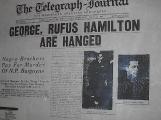
14
Hamilton Brothers - It was quite possibly the most infamous case in Fredericton's history. Though the details may be vague and the exact date may escape them, many of the city's residents can still recall the night that George and Rufus Hamilton went to the gallows.The crime sealing the fate of these young men from Barker's Point took place January 7th, 1949. On that evening, George (23) and Rufus (22) Hamilton called a taxi, a phone call which ultimately led to the brutal murder of the driver, Norman "Silver" Burgoyne. The resultant trial raised more questions than it answered due to contradictory testimony and the fact that each tried to pin the crime on the other. Both, however, would pay for the crime that the Deputy Attorney General described as "one of the most cold-blooded, planned, and brutally executed murders in the history of New Brunswick." There was little question, once they were found guilty, as to what their ultimate fate would be: A murder conviction called for a mandatory death sentence!
Interview with Paddy Gregg - "The evening that George and Rufus were hanged the roofs were crowded. There were kids and young adults perched on those roofs like…like black birds around a pea patch all waiting for this moment."
